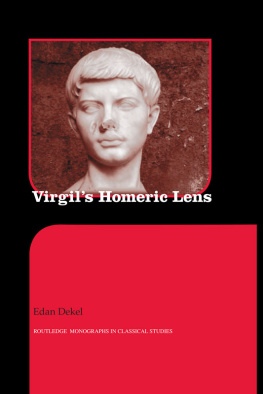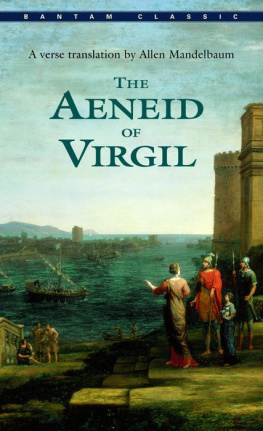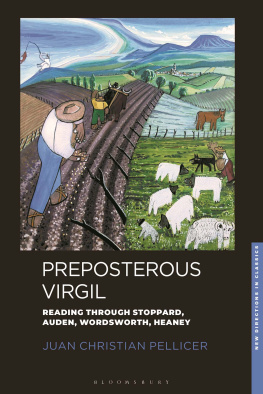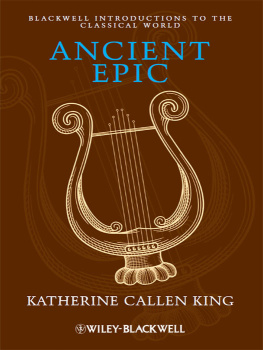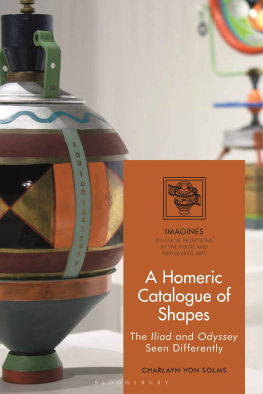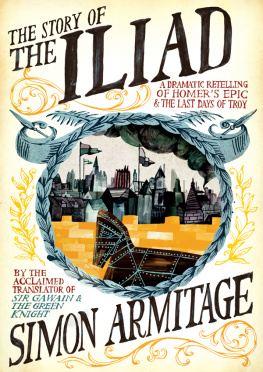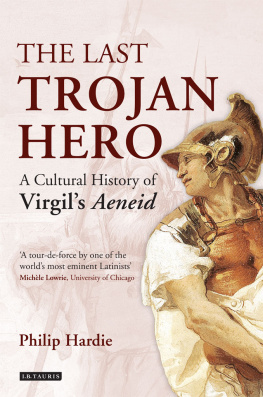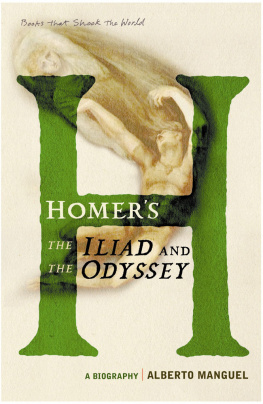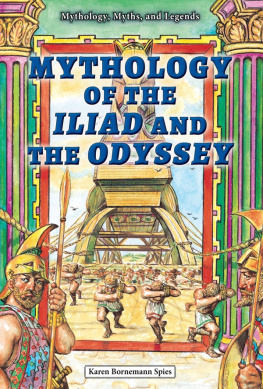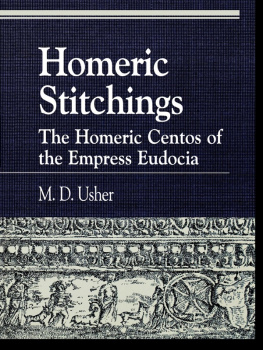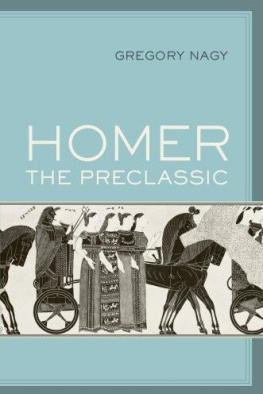Virgils Homeric Lens
Routledge Monographs in Classical Studies
The Roman Garden
Katharine T. von Stackelberg
The Eunuch in Byzantine History and Society
Shaun Tougher
Actors and Audience in the Roman Courtroom
Leanne Bablitz
Life and Letters in the Ancient Greek World
John Muir
Utopia Antiqua
Rhiannon Evans
Greek Magic
John Petropoulos
Between Rome and Persia
Peter Edwell
Passions and Moral Progress in Greco-Roman Thought
John T. Fitzgerald
Dacia
Ioana A. Oltean
Rome in the Pyrenees
Simon Esmonde-Cleary
Virgils Homeric Lens
Edan Dekel
Virgils Homeric Lens
Edan Dekel

First published 2012
by Routledge
711 Third Avenue, New York, NY 10017
Simultaneously published in the UK
by Routledge
2 Park Square, Milton Park, Abingdon, Oxon OX14 4RN
Routledge is an imprint of the Taylor & Francis Group, an informa business
2012 Taylor & Francis
The right of Edan Dekel to be identified as author of this work has been asserted by him in accordance with sections 77 and 78 of the Copyright, Designs and Patents Act 1988.
All rights reserved. No part of this book may be reprinted or reproduced or utilised in any form or by any electronic, mechanical, or other means, now known or hereafter invented, including photocopying and recording, or in any information storage or retrieval system, without permission in writing from the publishers.
Trademark Notice: Product or corporate names may be trademarks or registered trademarks, and are used only for identification and explanation without intent to infringe.
Library of Congress Cataloging-in-Publication Data
Dekel, Edan, 1975
Virgils Homeric lens / by Edan Dekel.
p. cm. (Routledge monographs in classical studies)
Includes bibliographical references and index.
1. Virgil. Aeneis. 2. VirgilKnowledgeGreek literature. 3. Epic poetry, LatinHistory and criticism. 4. Epic poetry, GreekHistory and criticism. 5. Latin poetryGreek influences. 6. HomerInfluence. 7. Homer. Iliad. 8. Homer. Odyssey. 9. Intertextuality. I. Title.
PA6825.D455 2011
873.01dc22
2011005701
ISBN13: 978-0-415-89040-3 (hbk)
ISBN13: 978-0-203-80622-7 (ebk)
For my mother and father
Contents
Acknowledgments
I would like to thank the many teachers, colleagues, students, and friends who have contributed to this book in various ways. In addition to providing valuable comments on early drafts, Ralph Hexter was instrumental in helping me hone my ambitious epic designs into a project of more reasonable scope and greater relevance. Mark Griffith, Ellen Oliensis, and Robert Alter also read earlier incarnations of this work and provided insightful criticism throughout. I am grateful to Michael Putnam and Joseph Pucci for planting the original seeds for this work many years ago during my time as an undergraduate at Brown University. I also owe special thanks to Joseph Pucci for reading and commenting on the manuscript at a crucial stage in the project. The manuscript was substantially revised during a happy year spent as a fellow at the Oakley Center for the Humanities and Social Sciences at Williams College, where Michael Brown and Rosemary Lane provided much assistance. I would also like to thank my colleagues in the Classics department at Williams, Meredith Hoppin, Kerry Christensen, Amanda Wilcox, Ben Rubin, and David Porter, for their enormous generosity and support throughout the project. My colleagues in Jewish Studies and Religion also offered valuable perspectives and encouragement, particularly Steve Gerrard, Sarah Hammerschlag, Ali Garbarini, and Denise Buell. Likewise, the students in my annual course on Virgil helped bring many important questions into specific relief. My debts to my longtime research partner and collaborator on so many projects, Gantt Gurley, are too numerous to list here. I also owe a special debt of gratitude to all the family and friends who supported me over the years, particularly my parents and brother, who sustained me in so many ways, and my daughter, Mai, who came into the world to inspire me during the very last stages of the project. Finally, this work would not exist without the boundless patience and optimism of my wife, Alexis Dekel. She is my ideal reader.
Permissions
Latin citations of Virgil are from the edition of R. A. B. Mynors, P. Vergili Maronis Opera (Oxford, 1969). Used by permission of Oxford University Press.
1 Primary Colors
One of the fundamental problems in the long history of criticism regarding Virgils use of the two Homeric poems in the Aeneid is the failure to recognize that because there are three texts involved in the process, there are three distinct relationships. Traditionally, the two Homeric poems are mined for sources of allusions and echoes in the Aeneid independently of each other, but little attention is paid to the ways in which Virgil reads the interaction between the Iliad and Odyssey themselves. Virgil does not simply appropriate various Iliadic and Odyssean scenes, themes, similes, and individual lines; he is constantly engaged in the creative act of reading the two texts against each other. This reading is neither haphazard nor mechanical in its manifestation. Virgil is writing an epic in the Homeric tradition, so he locates a certain hierarchy already embedded in that tradition and proceeds to read the relationship between the two poems accordingly.
For Virgil, the two Homeric poems are not completely coordinate. As a poem about the heros return from the Trojan War, the Odyssey necessarily positions itself as taking place after the Iliad, and as a consequence of the war described in that Iliad. But at the same time, the Odyssey is also an interpretation, or perhaps even a rendition, of the Iliad. Characters, themes, and conflicts from the war are evaluated and reconfigured as an authorative account of central Iliadic concerns. This book examines some specific ways in which Virgil uses the notion of the Odyssey as a reading of the Iliad and its aftermath to inform his own epic project, while constantly challenging the Odysseys claim to being the best reading of the Iliad. I aim to show that the Aeneid undertakes the Odysseys program of exploring multiple outcomes of the Trojan war while using the Odyssey itself to provide context for this exploration. Virgil positions the Aeneid in relation to the Iliad through the Odysseys own manipulations of the post-Iliadic experience.
In this first chapter, I will explore the history and methodology of Virgilian intertextual criticism starting with the commentators of late antiquity in order to reorient the underlying premise of bipartite, unidirectional influence of the Homeric poems on the Aeneid. By examining the links between discrete, local allusions and the comprehensive adoption of epic technique, and also treating the explicit demands of reading three distinct texts together as opposed to taking the Homeric poems as a univocal corpus, I will describe a system in which Virgil bases his own active interpretation and adaptation of Homer on the interaction between the Odyssey and the Iliad themselves. This design allows the Aeneid to process the content of both poems individually and taken together as a dynamic intertextual pair. Virgil uses the
Next page
